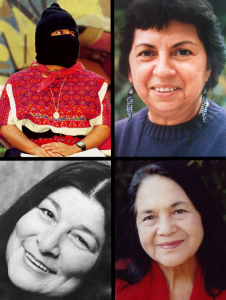4 Awesome Latinas To Know For Women’s History Month
 Latinas are so often filtered through the media’s racist and narrow lens. According to the TV, we are sexy, spicy, angry, submissive, and/or really skilled at cleaning. Sometimes we wear leopard print. Sometimes we wear aprons! It’s nearly impossible to undo decades and decades of stereotypical portrayals in the media, but I make the effort to fight these generalizations both in my writing and in my everyday life.
Latinas are so often filtered through the media’s racist and narrow lens. According to the TV, we are sexy, spicy, angry, submissive, and/or really skilled at cleaning. Sometimes we wear leopard print. Sometimes we wear aprons! It’s nearly impossible to undo decades and decades of stereotypical portrayals in the media, but I make the effort to fight these generalizations both in my writing and in my everyday life.
As much as I like leopard print, I stay strong and just say no. I also refuse to clean in any situation whatsoever, much to my boyfriend’s chagrin. In the spirit of this effort to fight stereotypes, I have compiled a list of Latina bad asses you should know about, please note that this is not meant to be a complete list.
For if I were to cover every Latina chingona, I would have to write tome after tome, and I would have carpal tunnel so severe that my hands would begin to resemble hideous claws. This is simply a short lost of a few Latinas I admire. I am also aware that there is a Mexican/Chicana bias here, so please don’t send me angry letters.
Dolores Huerta
A few months ago, I was fortunate enough to attend the Latinos in Social Media Conference where Dolores Huerta was a surprise guest speaker. When they announced her name after dinner, I loudly blurted an expletive in sheer excitement, startling the more dignified people at our table. Huerta is one of the women I most admire for her civil rights activism. She was a leader in the United Farm Worker’s 1965 grape boycott, which brought attention to the plight of migrant workers. The boycott forced California’s grape industry to sign a “collective bargaining agreement with the union, the first time farm workers had been able to achieve such a feat.” Huerta is also a feminist and early on “consciously began to challenge gender discrimination within the farm workers movement.” She has accumulated numerous honors throughout her life, and at the age of 81, continues her activism as the President of the Dolores Huerta Foundation.
Mercedes Sosa
An Argentine singer from humble beginnings. As an adolescent she won a radio station’s singing competition and subsequently went on to record an album. She had a very prolific musical career, collaborating with many international artists, such as Silvio Rodriguez, Joan Baez, and Lila Downs, and recorded a total of 40 albums. She was also an indigenous rights activist and towards the end of her life, fought to conserve the environment. During Argentina’s military regime under Jorge Videla, she was even arrested then exiled for her political beliefs. She was and continues to be considered “the voice of voiceless ones.” In 2008, a year before her death, she was also named a UNESCO Goodwill Ambassador. Her music is beautiful, powerful, and often socially conscious. I am not ashamed to admit that her song “Todo Cambia” makes my eyes leak sometimes.
Comandanta Ramona
First, I must have to note how cute this woman was. I don’t mean to be condescending, but seriously, her little hat and mask were adorable. Ramona was a tiny package of fury and revolution. She led the Zapatista uprising on New Year’s Day 1994 in San Cristobal, Mexico when they revolted in response to Mexico’s involvement in the North American Free Trade Agreement that took effect that day. The Zapatistas also demanded greater rights for the indigenous people of Chiapas. Before the uprising, Ramona was also a leading women’s rights activist. She was a truly inspirational woman. The cute Zapatist doll that I keep on my dresser often reminds me of her fiery spirit.
Gloria Anzaldua
A queer Chicana feminist writer. I remember first reading Anzaldúa in high school when my brother gave me one of her essays in which she described what is was like to be a rebellious Mexican daughter. I especially related to the part in which she describes her resentment of housework (my hostility against cleaning started early on in life). I shared the same anger and frustrations and her writing was incredibly comforting at that time. Her identity grounded in the Indian woman’s history of resistance was inspiring. She describes this fear of rebelling against our culture and home: “As a refugee, she leaves the familiar and safe homeground to venture into unknown and possibly dangerous terrain. / This is her home/ this thin edge of / barbwire.” I think her work has made this dangerous space safer for all of us.
[Photos By Freedom To Marry; jaloisiosolares; bastian; K Kendall]
